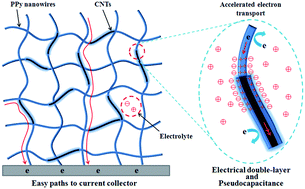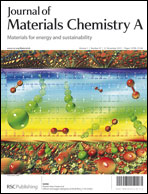Carbon nanotube reinforced polypyrrole nanowire network as a high-performance supercapacitor electrode†
Abstract
A carbon nanotube reinforced polypyrrole nanowire network was constructed by in situ polymerization of pyrrole in the presence of carbon nanotubes using cetyltrimethylammonium bromide micelles as a soft template. Carbon nanotubes as a reinforcer were embedded into a network of polypyrrole nanowires, thus retaining in the latter a complete network. The resulting network possessed a specific surface area of 112.1 m2 g−1 and a rough porous structure. The embedding of carbon nanotubes decreased the charge transfer resistance in the polypyrrole nanowires and allowed easy access and rapid diffusion of ions/electrons. When applied as a capacitive electrode, a specific capacitance of 183.2 F g−1 was observed at a current density of 8 A g−1. The specific capacitance retention was 85% after 1000 cycles at 1 A g−1. An asymmetric supercapacitor was fabricated using the network as a positive electrode and active carbon as a negative electrode, and when operated at a maximum voltage of 1.5 V, had a high energy density (15.1 W h kg−1 at 3000 W kg−1). A long-term cycling test of the asymmetric supercapacitor at a current density of 1 A g−1 displayed a capacitance retention of 72% even after 3000 cycles of charge and discharge.


 Please wait while we load your content...
Please wait while we load your content...